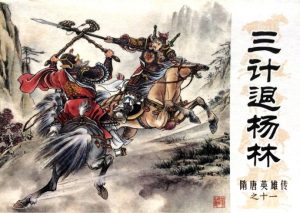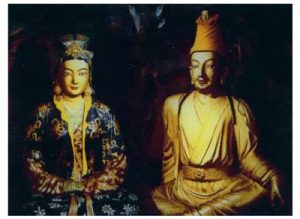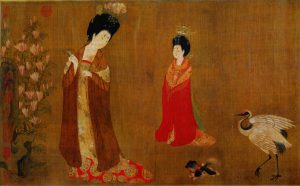
By the time Li Yuan forced the reigning Emperor Gong of the Sui Dynasty (581-618) to abdicate, the Sui Empire had already been divided up amongst a host of violent warlords. Although he proclaimed himself Emperor Gaozu of the Tang Dynasty, Li Yuan had a long way to go before he could call himself Emperor of a unified China! Li Mi ruled the area surrounding Luoyang, Dou Jiande controlled the northeast, Xue Ju dominated the northwest, Wang Shichong and the Sui remnants had overtaken Luoyang, and Yuwen Huaji led the remaining Sui armies. With these five formidable enemies to contend with, Emperor Gaozu set out on a military campaign that would last six long years.
Unfortunately, when he finally did unite China under his rule, the empire was on the verge of bankruptcy! Thus his first act as Emperor was to implement an administration that was small, simple, and cheap. He modelled this administration on that of the Sui Dynasty, and even went so far as to fill the highest governmental ranks with former Sui officials. Like the Sui, he also exerted significant control over provincial appointments and would frequently amalgamate prefectures or counties, so as to reduce their number. This helped to centralise his authority, as power was evenly distributed amongst his officials and therefore none of them could amass enough influence to challenge him.
Although he is rarely cited for special praise, Gaozu was the one who laid down the foundation for future Tang rulers. The institutions that he established in the 7th century would survive well into the mid-8th century, which was considered the apex of the Tang Dynasty. By centralising imperial rule, standardising the administration, and keeping it cost effective, Emperor Gaozu set up a model that would provide lasting success for his descendants.
Yet, as he grew older, he had a whole new problem to contend with; sibling rivalry! His sons Crown Prince Jiancheng and Li Shimin were embroiled in a bitter debate over who should succeed him. While it seemed as though Jiancheng was going to come out on top, Li Shimin took matters into his own hands by staging a military coup and killing Jiancheng, along with another of his brothers. In 626, he forced his father to abdicate and took the throne as Emperor Taizong.
In spite of his arguably immoral rise to power, Taizong proved to be a worthy and venerable ruler. He developed and refined many of the policies that his father had laid down, as well as making several notable innovations himself. By establishing tax relief in places stricken by natural disasters and relief granaries to provide citizens with food in case of a famine, he helped ensure that the poorer rural communities were able to prosper. His reign was marked by frugality in government and fortune for the common people.

In fact, Taizong wasn’t just a hit with his own people; he also implemented a hugely successful foreign policy! During his reign, he extended China’s western borders even farther than the Han Dynasty (206 BC–220 AD) did during its peak. Trade along the Silk Road between China, Central Asia, and the West flourished, and the imperial court received foreign ambassadors from as far as Persia and the Byzantine Empire. Foreign relations were improved through marital alliances, for example that of Princess Wencheng, a member of the royal family who was married to King Songtsän Gampo of the Tibetan Empire and who furthered the dissemination of Han Chinese culture in Tibet. The imperial capital of Chang’an (modern-day Xi’an) was bustling with foreign merchants, foreign monks, and a variety of non-Chinese peoples, who accelerated the pace of cultural exchange in northern China.
Tragically, as Taizong grew older, his grip on the imperial court gradually weakened. During the 640s, a bitter struggle broke out over who should succeed him, with factions of officials each supporting different candidates. In the end, it was Taizong’s son Li Zhi who was chosen, in spite of his generally weak character. In 649, he took the throne as Emperor Gaozong.

Yet it seemed that Gaozong was doomed to have power slip through his frail fingers. He had become enchanted by one of his father’s concubines, Wu Meiniang, and swiftly re-instated her as his own consort in the palace. Little did he know that she would turn out to be his undoing. After a series of complex schemes, Wu Zhao managed to have the reigning empress deposed and was appointed in her place as Empress Wu Zetian. While Gaozong faded into obscurity, Wu Zetian rose to become one of the most remarkable women in Chinese history.
Her ruthless political strategies were legendary and, when Gaozong suffered a debilitating stroke in 660, she took charge of the imperial administration. Emperor Zhongzong succeeded Gaozong on his death in 683, but the real power remained with Empress Dowager Wu. In less than a year, she had deposed Zhongzong and replaced him with the far more pliable Emperor Ruizong. By employing an army of agents and informers in the royal court, Empress Dowager Wu inspired fear in the hearts of the Tang ruling class. After putting down a serious rebellion in 684, no one dared to challenge her.